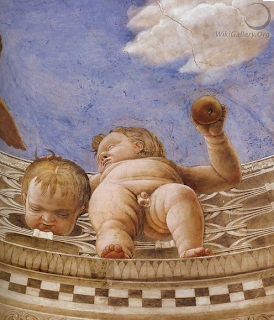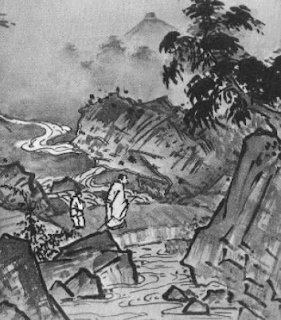Hatching is done by artist by creating parallel lines, the closer the spacing of the lines the darker the area is. Hatching creates good images of shadows from another object. In this example Looking into a hand-mirror II Mary Cassatt displays a example of hatching. Mary's work with hatching in this imagine is used very well with the woman and child's hair as well as how detailed the shadowing is behind the child's back.
Atmospheric Perspective
 Atmospheric perspective is when objects such as mountains change their appearance, objects further away from us appear less distinct, often bluer in color and the contrast between light and dark is reduced. Madonna with the Yarnwinder by Leonardo da Vinci displays this perspective by the mountains in the background do not seem to be that far away which we know they truly are. The mountains also seem to have a blue tint to them.
Atmospheric perspective is when objects such as mountains change their appearance, objects further away from us appear less distinct, often bluer in color and the contrast between light and dark is reduced. Madonna with the Yarnwinder by Leonardo da Vinci displays this perspective by the mountains in the background do not seem to be that far away which we know they truly are. The mountains also seem to have a blue tint to them.Arbitrary Color
Arbitrary color is when artist use colors that are not "true colors". In this painting Pierre Bonnard shows arbitrary color because trees are not blue, in this particular painting the tree on the left is. Also in this painting the woman standing next to the tree has a completion of her whole body blending in.
Analogous color is when a piece of art makes you feel a certain way. If a person see's a blue they think cold or the range from yellow to orange and red people think warm. In this piece Odysseus by Romare Bearden I think of death with the area covered in red as well as the skull being presented in the picture.  Texture
Texture
 Texture
Texture
Texture is how something is composed of, it could be rough on the skin or smooth or sharp. Texture can be many things. Feeling things is human nature but when it comes to pieces of art somethings are not meant to be touched. Michelangelo's Tomb of Lorenzo has a smooth like texture just looking at it but still as humans we would want to touch such a statue which we cannot or the pieces of work would be ruined.
Frottage is kind of a visual effect on a person. When we look at this Terre Ecossaise by Max Ernst we think that when we touch it, it would be wavy and smooth, but actually it would be flat and smooth. What frottage does is give us this visual effect because of how Max Ernst would place a piece of paper over a non flat surface and rub a pencil over it to gain these effects.




















